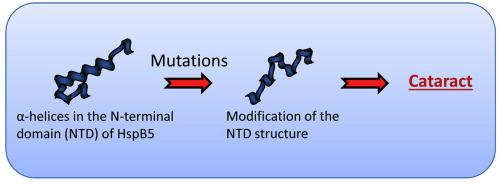Experimental Eye Research ( IF 3.4 ) Pub Date : 2020-06-10 , DOI: 10.1016/j.exer.2020.108091 Lydia K Muranova 1 , Sergei V Strelkov 2 , Nikolai B Gusev 1

|
Physico-chemical properties of three cataract-associated missense mutants of αB-crystallin (HspB5) (R11H, P20S, R56W) were analyzed. The oligomers formed by the R11H mutant were smaller, whereas the oligomers of the P20S and R56W mutants were larger than those of the wild-type protein. The P20S mutant possessed lower thermal stability than the wild-type HspB5 or two other HspB5 mutants. All HspB5 mutants were able to form heterooligomeric complexes with αA-crystallin (HspB4), a genuine component of eye lens. However, the P20S and R56W mutants were less effective in the formation of these complexes and properties of heterooligomeric complexes formed by these mutants and HspB4 and analyzed by ion-exchange chromatography were different from those formed by the wild-type HspB5 and HspB4. All HspB5 variants also heterooligomerized with another partner protein, HspB6. Specifically for the P20S mutant forming two distinct sizes of homooligomers, only the smaller homooligomer population was able to interact with HspB6. P20S and R56W mutants possessed lower chaperone-like activity than the wild-type HspB5 when UV-irradiated βL-crystallin was used as a model substrate. Importantly, all three mutations are localized in three earlier postulated short α-helical regions present in the N-terminal domain of αB-crystallin. These observations suggest an important structural and functional role of these regions. Correspondingly, therein localized mutations ultimately result in clinically relevant cataracts.
中文翻译:

白内障相关突变在αB-晶状蛋白(HspB5)N端结构域中的作用。
分析了三个白内障相关的αB-晶状体蛋白(HspB5)(R11H,P20S,R56W)的错义突变体的理化性质。R11H突变体形成的寡聚体较小,而P20S和R56W突变体的寡聚体大于野生型蛋白。与野生型HspB5或其他两个HspB5突变体相比,P20S突变体具有较低的热稳定性。所有的HspB5突变体都能与αA-晶状体蛋白(HspB4)(一种真正的晶状体成分)形成异源寡聚复合物。但是,P20S和R56W突变体在形成这些复合物时效率较低,并且由这些突变体和HspB4形成并通过离子交换色谱法分析的异寡聚复合物的性质与由野生型HspB5和HspB4形成的那些不同。所有HspB5变体也与另一种伴侣蛋白HspB6杂聚。特别是对于形成两个不同大小的同聚物的P20S突变体,只有较小的同聚物群体能够与HspB6相互作用。当紫外线照射β时,P20S和R56W突变体具有比野生型HspB5更低的伴侣样活性。L-晶状蛋白被用作模型底物。重要的是,所有三个突变均位于存在于αB-晶状蛋白N端结构域的三个较早假定的短α螺旋区域中。这些观察表明这些区域的重要结构和功能作用。相应地,其中的局部突变最终导致临床上相关的白内障。



























 京公网安备 11010802027423号
京公网安备 11010802027423号